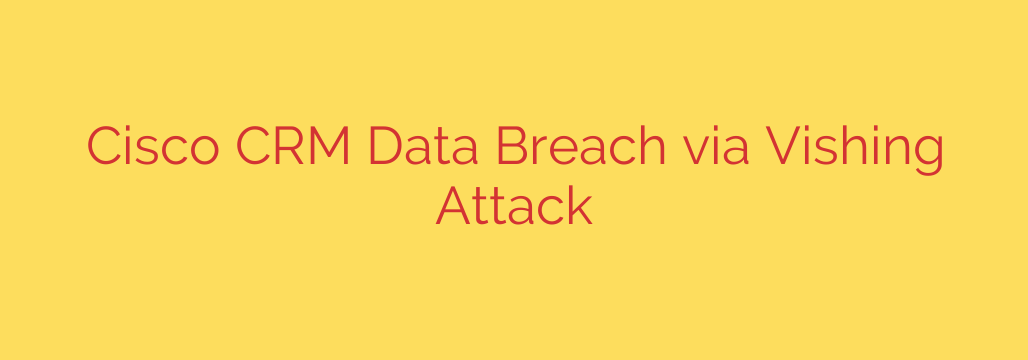
Anatomy of a Data Breach: How Vishing and MFA Fatigue Compromised a Corporate Network
In today’s complex cybersecurity landscape, attackers are increasingly blending technical exploits with sophisticated psychological manipulation. A recent high-profile security incident perfectly illustrates this trend, demonstrating how a determined adversary can bypass modern defenses by targeting the most vulnerable element: the human user. This breach serves as a critical case study for businesses on the evolving nature of cyber threats and the importance of a multi-layered defense strategy.
The attack didn’t start with a brute-force assault on corporate firewalls. Instead, the initial point of compromise was an employee’s personal Google account. Through a malicious file delivered via email, attackers gained access to the employee’s account. This seemingly minor, personal security lapse had major consequences because the employee had synchronized their web browser passwords with their Google account. The attackers were then able to harvest the employee’s saved credentials, which included login information for the corporate network.
The Attack Unfolds: Vishing and MFA Fatigue
With valid credentials in hand, the attackers faced their next obstacle: Multi-Factor Authentication (MFA). To circumvent this, they launched a sophisticated social engineering campaign.
First, they began a series of vishing (voice phishing) attacks, repeatedly calling the employee while posing as a trusted IT support representative. These calls were designed to build a false sense of trust and urgency.
Simultaneously, the attackers initiated the login process over and over, triggering a relentless flood of MFA push notifications to the employee’s mobile device. This tactic, known as MFA fatigue, is designed to annoy and exhaust the target. Under the pressure of the constant notifications and the convincing vishing calls, the employee eventually accepted one of the MFA prompts, believing they were approving a legitimate request from IT support.
This single moment of human error was the key that unlocked the kingdom. The successful MFA approval granted the attackers access to the company’s Virtual Private Network (VPN).
Inside the Network: Lateral Movement and Data Exfiltration
Once inside the corporate network, the attackers began to move laterally, escalating their privileges and mapping out the internal environment. They managed to gain access to directory services, which provided them with a deeper understanding of the network’s structure and user accounts.
Their ultimate goal appeared to be financial extortion. The attackers successfully accessed and exfiltrated data from a Customer Relationship Management (CRM) system hosted in the cloud. Fortunately, the compromised data was limited to non-sensitive customer information, such as names, company names, and email addresses. No critical financial data, intellectual property, or sensitive customer details were reported to have been stolen.
The attackers also attempted to deploy ransomware, but their activity was detected by the company’s security team. The team was able to contain the threat, eject the intruders from the network, and prevent the encryption of any files.
Key Security Lessons and Actionable Advice
This incident provides several crucial takeaways for organizations of all sizes. Relying on technology alone is not enough; a robust security posture must address people, processes, and technology.
Educate Employees on Social Engineering: Regular, engaging security awareness training is non-negotiable. Employees must be taught to recognize the signs of vishing, phishing, and MFA fatigue attacks. Foster a culture where they feel empowered to reject, report, and verify any suspicious communication, even if it appears to come from an internal source like IT support.
Strengthen Your MFA Implementation: While any MFA is better than none, not all methods are created equal. Simple push notifications are susceptible to fatigue attacks. Businesses should consider upgrading to more secure MFA methods, such as number matching or biometric verification, which require a more deliberate action from the user and are harder to accidentally approve.
Enforce Separation of Personal and Professional Accounts: Strongly discourage or prohibit employees from using personal accounts (like a private Gmail) for work-related activities, including password management. Corporate credentials should never be stored in personal password managers or browser-based synchronization services. Use enterprise-grade password management solutions instead.
Implement Robust Monitoring and Response: The company’s ability to detect and eject the attackers before they could deploy ransomware was critical. This highlights the importance of having advanced security solutions like Endpoint Detection and Response (EDR) and a well-practiced Incident Response (IR) plan. Constant monitoring for unusual internal network activity is key to catching intruders before they can do maximum damage.
Ultimately, this breach serves as a stark reminder that as security controls evolve, so do the tactics of those seeking to break them. By understanding the methods attackers use and implementing layered defenses that protect both systems and people, businesses can significantly reduce their risk of becoming the next headline.
Source: https://securityaffairs.com/180816/data-breach/cisco-disclosed-a-crm-data-breach-via-vishing-attack.html








